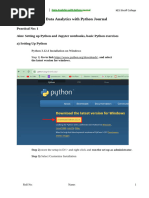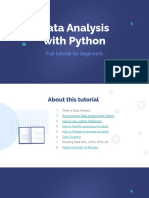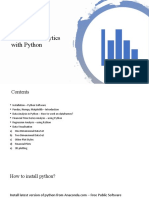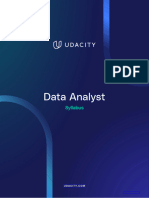0 ratings0% found this document useful (0 votes)
13 viewsData Analysis Python Notes
This document provides notes on Data Analysis using Python for 3rd Year B.Sc. students, covering key topics such as data types, libraries (NumPy, Pandas, Matplotlib, Seaborn), and data handling techniques. It includes examples of creating arrays, reading data, data cleaning, visualization methods, and basic statistical analysis. The content is structured into units that guide students through the essential concepts and practical applications of data analysis in Python.
Uploaded by
chiragal864Copyright
© © All Rights Reserved
We take content rights seriously. If you suspect this is your content, claim it here.
Available Formats
Download as PPTX, PDF, TXT or read online on Scribd
0 ratings0% found this document useful (0 votes)
13 viewsData Analysis Python Notes
This document provides notes on Data Analysis using Python for 3rd Year B.Sc. students, covering key topics such as data types, libraries (NumPy, Pandas, Matplotlib, Seaborn), and data handling techniques. It includes examples of creating arrays, reading data, data cleaning, visualization methods, and basic statistical analysis. The content is structured into units that guide students through the essential concepts and practical applications of data analysis in Python.
Uploaded by
chiragal864Copyright
© © All Rights Reserved
We take content rights seriously. If you suspect this is your content, claim it here.
Available Formats
Download as PPTX, PDF, TXT or read online on Scribd
You are on page 1/ 10
Data Analysis using Python
Notes for 3rd Year B.Sc. Students
Unit 1: Introduction to Data
Analysis and Python
• - Data Analysis: Inspecting, cleaning, modeling
data
• - Types of Data: Qualitative, Quantitative
• - Libraries: NumPy, Pandas, Matplotlib,
Seaborn
• - Environment: Jupyter Notebook
Unit 2: NumPy for Data Analysis
• - Create arrays: np.array(), np.zeros(),
np.arange()
• - Operations: Indexing, slicing, broadcasting
• - Functions: np.mean(), np.std(), np.sum()
Unit 2: NumPy Example
• import numpy as np
• a = np.array([1, 2, 3])
• print(np.mean(a)) # Output: 2.0
Unit 3: Pandas for Data Handling
• - Series and DataFrame structures
• - Read data: pd.read_csv(), pd.read_excel()
• - Select/Filter/Sort/Group: loc[], iloc[],
groupby()
Unit 3: Pandas Example
• import pandas as pd
• df = pd.read_csv("data.csv")
• print(df.head())
Unit 4: Data Cleaning and
Preprocessing
• - Handle missing: isnull(), dropna(), fillna()
• - Rename: df.rename(), Type conversion:
astype()
• - Drop duplicates: df.drop_duplicates()
Unit 5: Data Visualization
• - Matplotlib: plot(), bar(), hist(), scatter()
• - Seaborn: histplot(), boxplot(), heatmap()
Unit 5: Visualization Example
• import matplotlib.pyplot as plt
• import seaborn as sns
• sns.histplot(data=df, x='column_name')
• plt.show()
Unit 6: Basic Statistical Analysis
• - Descriptive stats: mean, median, std dev
• - Correlation: df.corr()
• - Value counts: df['col'].value_counts()
You might also like
- Data Analysis With Python - FreeCodeCampNo ratings yetData Analysis With Python - FreeCodeCamp26 pages
- Experiment No: 1 Introduction To Data Analytics and Python Fundamentals Page-1/11No ratings yetExperiment No: 1 Introduction To Data Analytics and Python Fundamentals Page-1/118 pages
- Course_ Introduction to Data Science (SD211105)No ratings yetCourse_ Introduction to Data Science (SD211105)10 pages
- 3rd Semester DDM AI DAA DEV Print Pages For Spiral Record 25-1-24 - RemovedNo ratings yet3rd Semester DDM AI DAA DEV Print Pages For Spiral Record 25-1-24 - Removed28 pages
- Data Analysis With Python: Full Tutorial For BeginnersNo ratings yetData Analysis With Python: Full Tutorial For Beginners26 pages
- Data Analysis With Python - FreeCodeCampNo ratings yetData Analysis With Python - FreeCodeCamp28 pages
- Data Analysis With Python - FreeCodeCamp PDFNo ratings yetData Analysis With Python - FreeCodeCamp PDF28 pages
- Data Analysis Using Python Day_1 to Day_4No ratings yetData Analysis Using Python Day_1 to Day_430 pages
- Usage of NumPy for Numerical Data in DetailNo ratings yetUsage of NumPy for Numerical Data in Detail52 pages
- Python For Data Analysts - Quick SummaryNo ratings yetPython For Data Analysts - Quick Summary6 pages
- SYLLABUS ANALYZING,VISUALIZING, DATA SCIENCE MINORNo ratings yetSYLLABUS ANALYZING,VISUALIZING, DATA SCIENCE MINOR3 pages
- Python Data Analysis Second Edition Armando Fandangoinstant download100% (1)Python Data Analysis Second Edition Armando Fandangoinstant download54 pages
- Chapter 2. Data Analysis and Processing - FullNo ratings yetChapter 2. Data Analysis and Processing - Full49 pages
- Data Analyst Nanodegree Program - SyllabusNo ratings yetData Analyst Nanodegree Program - Syllabus7 pages
- Python For DScience & D Visualisation UpdatedNo ratings yetPython For DScience & D Visualisation Updated11 pages
- Session3 - Analytics For Programming II - Siryani - 090524No ratings yetSession3 - Analytics For Programming II - Siryani - 09052428 pages
- Advertisement For Engagement of One Post of Advisor Technical atNo ratings yetAdvertisement For Engagement of One Post of Advisor Technical at6 pages

































































